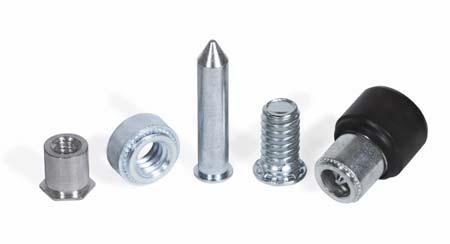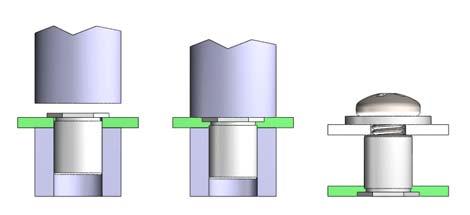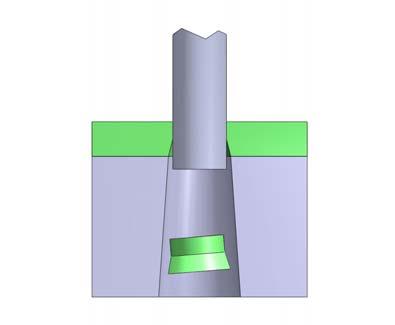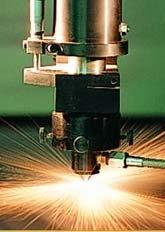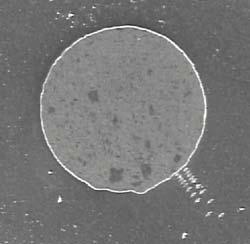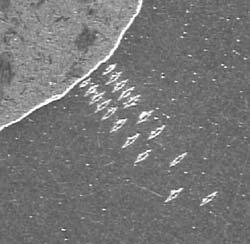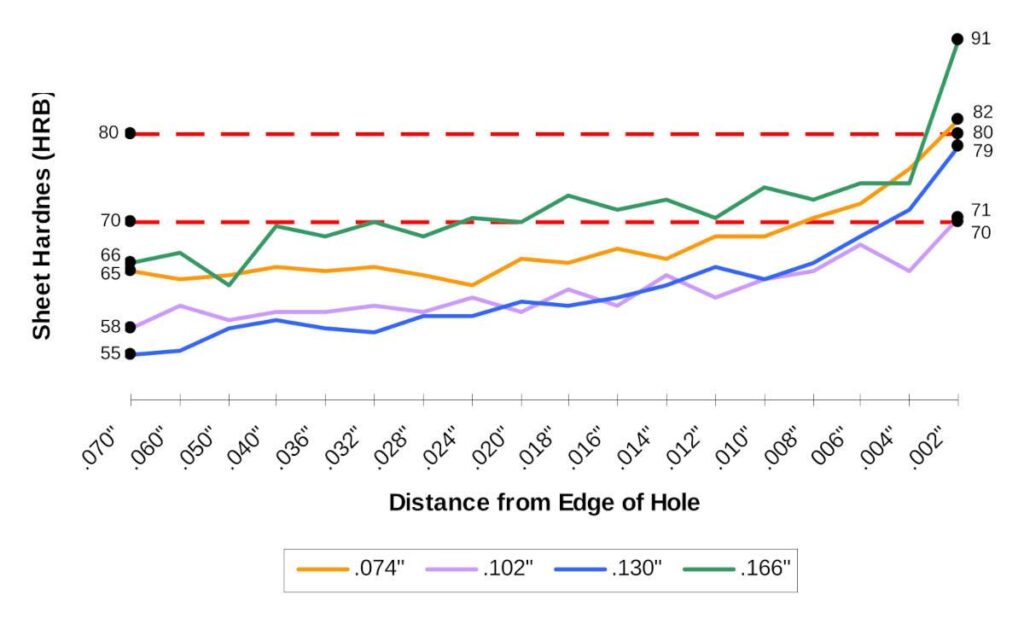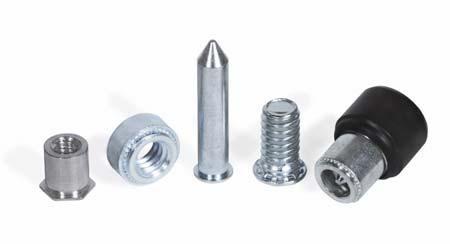
Introduction
Self-clinching fasteners are pressed into holes in ductile metal sheets to create a permanent union with the host material and replace one or more pieces of traditional loose hardware or extruded/tapped holes in panels and brackets, Figure 1. A portion of the fastener is pressed into and displaces the sheet material around the hole causing the transposed material to cold flow into and around specially designed annular recesses and knurled or grooved rings, Figure 2. Two important considerations in the design of self-clinching fasteners is that their material must be significantly harder than the sheet material otherwise the fastener will deform instead of causing the necessary base material displacement, and the hole in the sheet must have a diameter just slightly larger (usually only a couple thousandths of an inch) than the portion of the fastener being inserted in the sheet. The two most common self-clinching fastener materials are heat-treated low carbon steel and AISI 300-series stainless steel for installation in aluminum and low-carbon steel sheets. Creating holes in thick sheets by punching or laser-cutting can violate these two fundamentals and prevent proper installation leading to poorly secured fasteners unless additional steps are taken.
Punched Holes in Thick Sheets
In medium to high- production metalworking, the most common method of creating holes in sheet metal is to pierce a hole using a punch. Made from hardened steel or carbide, the punch is forced through the sheet with a press. A die on the opposite side of the work piece supports the edge of the hole being created. The diameter of the punch-side of the hole will match that of the punch and have smooth burnished walls. However because a small amount of clearance is required between the punch and die, approximately half way through the hole the walls will experience “die break” resulting in a rough surface and a hole diameter on the die side closely matching that of the die. As the sheet thickness increases, so must the clearance between punch and die resulting in a bell- shaped hole with diameter on the die side possibly exceeding the recommended hole diameter for the self-clinching fastener, Figure 3. An application analysis of self-clinching standoffs falling out under light pressure after installation revealed that the hardware was installed from the die-side in characteristic bell-shaped holes in .134” thick sheets. In this example, parts were also installed from the punch side and the resulting gap around the fastener indicated that any fastener installed on the die-side would be installed in a similar over-sized hole, Figure 4. This particular standoff required a .281”-.284” diameter hole in the sheet metal. The hole diameter on the die-side measured .291” consequently not permitting an adequate amount of material to be displaced during installation and flow into the standoff recess.
Generally, sheets less than .090” thick are unaffected as the punch/die clearance is small enough to avoid bell-shaped holes with die-side diameters exceeding recommended fastener hole diameters. For thicker panels, self-clinching fasteners should be installed on the punch-side of the hole, or punch the hole under size and ream to the proper diameter.
Laser-cut Holes
In smaller production volumes, a popular method for forming holes in sheets is to melt, burn or vaporize the metal with a high-power laser, Figure 5. An investigation of installation failures of self-clinching nuts and standoffs in sheets with laser-cut holes revealed that an unusually large amount of pressure was required to seat the fasteners during installation resulting in deformed nuts with tight threads, and standoffs that would not remain secured. Because during the laser cutting process the sheet metal is heated to melting temperatures and allowed to air cool, a heat-affected zone of increased hardness is created around the perimeter of the holes.
To verify this phenomena, low-carbon steel specimens of different thicknesses with laser-cut holes were mounted, polished and tested for micro hardness at the hole edges on both sides of the samples using a Knoop hardness test. Under a predetermined force, a pyramidal diamond point was pressed into the polished surface for a specified dwell time. The areas of the resulting indentations were measured under a microscope, used to correlate the Knoop hardness, and in this case converted to a Rockwell B-scale hardness, Figure 6. Typically, the maximum sheet hardness for self-clinching fasteners made from heat-treated carbon steel is HRB 80 and HRB 70 for fasteners from AISI 300-series stainless steel. Figure 7 shows significant increases in sheet metal hardness for four different sheet thicknesses while traversing progressively closer to the hole edges as a result of laser cutting the holes. In summary, the hole-edge hardness of three of the samples exceeded or nearly exceeded the recommended sheet hardness for heat-treated carbon steel fasteners while all samples exceeded the recommended sheet hardness for 300-series stainless steel fasteners.
The recommendation for laser-cut holes is similar to that of punched holes: create an undersized hole and ream to the correct diameter. However with laser-cut holes, the heat-affected zone needs to be removed. Since there are many factors that can affect the resulting hardness and extent of the heat-affected zone such as sheet metal thickness and material type, and laser temperature and cutting speed, determining the amount of material to removed can be difficult to estimate. Baseline testing is one possible solution to establish a material removal specification.
Conclusion
For proper installation of self-clinching fasteners their material must be significantly harder than the sheet metal and the sheet hole must have a tight tolerance diameter roughly a few thousandths larger than the fastener to create a permanent self- clinching union. Two popular methods of creating holes in thick sheets: punching and laser- cutting; can violate these principles by creating oversize holes or increasing the sheet hardness beyond the recommended limits leading to poorly secured fasteners. By following some additional manufacturing steps these holes can be amended for use with self- clinching fasteners.
Gregg V. Summers, M.S.E., P.E.
Director of Product Development
Gregg Summers is the Director of Product Development for PENCOM, Inc. – a leading global designer, manufacturer and supplier of custom and manufactured hardware. He has over 17 years experience in the design and testing of mechanical connections and fasteners.

